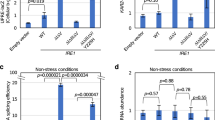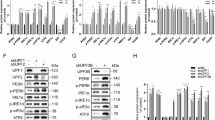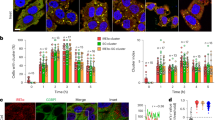Abstract
PERK and IRE1 are type-I transmembrane protein kinases that reside in the endoplasmic reticulum (ER) and transmit stress signals in response to perturbation of protein folding. Here we show that the lumenal domains of these two proteins are functionally interchangeable in mediating an ER stress response and that, in unstressed cells, both lumenal domains form a stable complex with the ER chaperone BiP. Perturbation of protein folding promotes reversible dissociation of BiP from the lumenal domains of PERK and IRE1. Loss of BiP correlates with the formation of high-molecular-mass complexes of activated PERK or IRE1, and overexpression of BiP attenuates their activation. These findings are consistent with a model in which BiP represses signalling through PERK and IRE1 and protein misfolding relieves this repression by effecting the release of BiP from the PERK and IRE1 lumenal domains.
This is a preview of subscription content, access via your institution
Access options
Subscribe to this journal
Receive 12 print issues and online access
$209.00 per year
only $17.42 per issue
Buy this article
- Purchase on SpringerLink
- Instant access to full article PDF
Prices may be subject to local taxes which are calculated during checkout







Similar content being viewed by others
References
Lee, A. Mammalian stress response: induction of the glucose-regulated protein family. Curr. Biol. 4, 267–273 ( 1992).
Brostrom, C. O. & Brostrom, M. A. Regulation of translational initiation during cellular responses to stress. Prog. Nucleic Acid Res. Mol. Biol. 58, 79– 125 (1998).
Chapman, R., Sidrauski, C. & Walter, P. Intracellular signaling from the endoplasmic reticulum to the nucleus. Annu. Rev. Cell Dev. Biol. 14, 459–485 (1998).
Kaufman, R. J. Stress signaling from the lumen of the endoplasmic reticulum: coordination of gene transcriptional and translational controls. Genes Dev. 13, 1211–1233 ( 1999).
Tirasophon, W., Welihinda, A. A. & Kaufman, R. J. A stress response pathway from the endoplasmic reticulum to the nucleus requires a novel bifunctional protein kinase/endoribonuclease (Ire1p) in mammalian cells. Genes Dev. 12, 1812–1824 (1998).
Wang, X. Z. et al. Cloning of mammalian Ire1 reveals diversity in the ER stress responses. EMBO J. 17, 5708– 5717 (1998).
Shi, Y. et al. Identification and characterization of pancreatic eukaryotic initiation factor 2 alpha-subunit kinase, PEK, involved in translational control. Mol. Cell Biol. 18, 7499–7509 (1998).
Harding, H., Zhang, Y. & Ron, D. Translation and protein folding are coupled by an endoplasmic reticulum resident kinase. Nature 397, 271– 274 (1999).
Munro, S. & Pelham, H. R. An Hsp70-like protein in the ER: identity with the 78 kDa glucose- regulated protein and immunoglobulin heavy chain binding protein. Cell 46, 291– 300 (1986).
Wei, J. & Hendershot, L. M. Characterization of the nucleotide binding properties and ATPase activity of recombinant hamster BiP purified from bacteria. J. Biol. Chem. 270, 26670 –26676 (1995).
Hebert, D. N., Simons, J. F., Peterson, J. R. & Helenius, A. Calnexin, calreticulin, and Bip/Kar2p in protein folding. Cold Spring Harb. Symp. Quant. Biol. 60, 405– 415 (1995).
Dorner, A., Wasley, L. & Kaufman, R. Overexpression of GRP78 mitigates stress induction of glucose regulated proteins and blocks secretion of selective proteins in Chinese hamster ovary cells. EMBO J. 11, 1563– 1571 (1992).
Wang, et al. Signals from the stressed endoplasmic reticulum induce C/EBP homologous protein (CHOP/GADD153). Mol. Cell Biol. 16, 4273 –4280 (1996).
Shamu, C. E. & Walter, P. Oligomerization and phosphorylation of the Ire1p kinase during intracellular signaling from the endoplasmic reticulum to the nucleus. EMBO J. 15, 3028– 3039 (1996).
Welihinda, A. A. & Kaufman, R. J. The unfolded protein response pathway in Saccharomyces cerevisiae. Oligomerization and trans-phosphorylation of Ire1p (Ern1p) are required for kinase activation. J. Biol. Chem. 271, 18181– 18187 (1996).
Langland, J. O. & Jacobs, B. L. Cytosolic double-stranded RNA-dependent protein kinase is likely a dimer of partially phosphorylated Mr 66,000 subunits. J. Biol. Chem. 267 , 10729–10736 (1992).
Reinhard, C., Shamoon, B., Shyamala, V. & Williams, L. T. Tumor necrosis factor alpha-induced activation of c-jun N-terminal kinase is mediated by TRAF2. EMBO J. 16, 1080– 1092 (1997).
Bukau, B. & Horwich, A. L. The Hsp70 and Hsp60 chaperone machines. Cell 92, 351– 366 (1998).
Matlack, K. E., Misselwitz, B., Plath, K. & Rapoport, T. A. BiP acts as a molecular ratchet during posttranslational transport of prepro-alpha factor across the ER membrane. Cell 97, 553–564 (1999).
Liberek, K., Galitski, T. P., Zylicz, M. & Georgopoulos, C. The DnaK chaperone modulates the heat shock response of Escherichia coli by binding to the sigma 32 transcription factor. Proc. Natl Acad. Sci. USA 89, 3516–3520 (1992).
Gamer, J., Bujard, H. & Bukau, B. Physical interaction between heat shock proteins DnaK, DnaJ, and GrpE and the bacterial heat shock transcription factor sigma 32 . Cell 69, 833–842 (1992).
Tomoyasu, T., Ogura, T., Tatsuta, T. & Bukau, B. Levels of DnaK and DnaJ provide tight control of heat shock gene expression and protein repair in Escherichia coli. Mol. Microbiol. 30, 567–581 (1998).
Morimoto, R. I. Regulation of the heat shock transcriptional response: cross talk between a family of heat shock factors, molecular chaperones, and negative regulators . Genes Dev. 12, 3788–3796 (1998).
Zou, J., Guo, Y., Guettouche, T., Smith, D. F. & Voellmy, R. Repression of heat shock transcription factor HSF1 activation by HSP90 (HSP90 complex) that forms a stress-sensitive complex with HSF1. Cell 94, 471–480 ( 1998).
Straus, D. B., Walter, W. A. & Gross, C. A. The activity of sigma 32 is reduced under conditions of excess heat shock protein production in Escherichia coli. Genes Dev. 3, 2003–2010 (1989).
Kohno, K., Normington, K., Sambrook, J., Gething, M. J. & Mori, K. The promoter region of the yeast KAR2 (BiP) gene contains a regulatory domain that responds to the presence of unfolded proteins in the endoplasmic reticulum. Mol. Cell Biol. 13, 877–890 (1993).
Freiden, P. J., Gaut, J. R. & Hendershot, L. M. Interconversion of three differentially modified and assembled forms of BiP. EMBO J. 11, 63–70 (1992).
Hendershot, L. M. et al. In vivo expression of mammalian BiP ATPase mutants causes disruption of the endoplasmic reticulum. Mol. Biol. Cell 6, 283–296 ( 1995).
Bertolotti, A. et al. EWS, but not EWS-FLI-1, is associated with both TFIID and RNA polymerase II: interactions between two members of the TET family, EWS and hTAFII68, and subunits of TFIID and RNA polymerase II complexes. Mol. Cell Biol. 18, 1489–1497 (1998).
Acknowledgements
We thank G. Kreibich for the anti-ribophorin antiserum, D. Littman for CD4 cDNA and monoclonal antibody, R. Kaufman and A. Dorner for CHO.BiPoe cells, M. A. Gawinowicz for mass spectroscopy and J-P. Simon for help with glycerol gradients. This work was supported by NIH grants (ES08681 and DK47119) to D.R., National Research Service award (NRSA) to H.P.H. and EMBO and Human Frontier Science programme awards to A.B. D.R. is a Stephen Birnbaum Scholar of the Leukaemia Society of America.
Correspondence and requests for materials should be addressed to D.R.
Author information
Authors and Affiliations
Corresponding author
Rights and permissions
About this article
Cite this article
Bertolotti, A., Zhang, Y., Hendershot, L. et al. Dynamic interaction of BiP and ER stress transducers in the unfolded-protein response. Nat Cell Biol 2, 326–332 (2000). https://doi.org/10.1038/35014014
Received:
Revised:
Accepted:
Published:
Issue Date:
DOI: https://doi.org/10.1038/35014014



